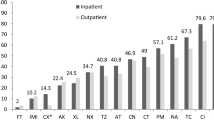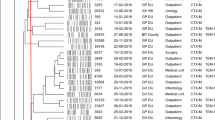Abstract
Escherichia coli cause the majority of urinary tract infections (UTIs). Virulence plays an important role in the initial stages of interaction with the host, facilitating colonization of the urinary tract tissue. The purpose of this study was to assess whether there is a relationship between virulence and antibiotic resistance in the persistence of uropathogenic E. coli strains. This study included five patients with UTI between 2001 and 2009. The antibiotic resistance phenotype of 29 E. coli isolates was determined by the disk diffusion method. Clonal relationship was determined through M13 polymerase chain reaction (PCR) fingerprinting. Phylogeny, virulence factors, β-lactamases, and replicon typing were studied through PCR. Antibiogram profiles were found from different patients and corresponded to CTX-M-2, CTX-M-15, CTX-M-32, and TEM-52 enzymes. Plasmids belonged essentially to incompatibility group IncF. No clonal relationship was observed among isolates from different patients, except for patients 4 and 5. Phylogenetic group A was predominant. Our work showed that commensal group A possesses the same virulence factors as the pathogenic groups B1 and D. E. coli common pilus and type 1 fimbriae could play an important role in the persistence in the host and in symptomatic UTI, respectively, which, combined with extended-spectrum β-lactamases (ESBLs), are a cause of the dissemination of microorganisms in the hospital and the community.
Similar content being viewed by others
References
Foxman B (2003) Epidemiology of urinary tract infections: incidence, morbidity, and economic costs. Dis Mon 49(2):53–70
Escobar-Páramo P, Clermont O, Blanc-Potard AB, Bui H, Le Bouguénec C, Denamur E (2004) A specific genetic background is required for acquisition and expression of virulence factors in Escherichia coli. Mol Biol Evol 21(6):1085–1094
Johnson JR, Kuskowski MA, Gajewski A, Sahm DF, Karlowsky JA (2004) Virulence characteristics and phylogenetic background of multidrug-resistant and antimicrobial-susceptible clinical isolates of Escherichia coli from across the United states, 2000–2001. J Infect Dis 190:1739–1744
Johnson JR, Owens K, Gajewski A, Kuskowski MA (2005) Bacterial characteristics in relation to clinical source of Escherichia coli isolates from women with acute cystitis or pyelonephritis and uninfected women. J Clin Microbiol 43(12):6064–6072
Piatti G, Mannini A, Balistreri M, Schito AM (2008) Virulence factors in urinary Escherichia coli strains: phylogenetic background and quinolone and fluoroquinolone resistance. J Clin Microbiol 46(2):480–487
Bradford PA (2001) Extended-spectrum β-lactamases in the 21st century: characterization, epidemiology, and detection of this important resistance threat. Clin Microbiol Rev 14(4):933–951
Colodner R, Rock W, Chazan B, Keller N, Guy N, Sakran W, Raz R (2004) Risk factors for the development of extended-spectrum β-lactamase-producing bacteria in nonhospitalized patients. Eur J Clin Microbiol Infect Dis 23:163–167
Cantón R, Coque TM (2006) The CTX-M β-lactamase pandemic. Curr Opin Microbiol 9:466–475
Machado E, Coque TM, Cantón R, Novais A, Sousa JC, Baquero F, Peixe L; Portuguese Resistance Study Group (2007) High diversity of extended-spectrum beta-lactamases among clinical isolates of Enterobacteriaceae from Portugal. J Antimicrob Chemother 60(6):1370–1374
Coque TM, Baquero F, Canton R (2008) Increasing prevalence of ESBL-producing Enterobacteriaceae in Europe. Euro Surveill 13(43):pii=19044
Barroso H, Freitas-Vieira A, Duarte A (1999) Molecular characterization of a ceftazidime-resistant Morganella morganii isolate producing a TEM-10 β-lactamase. Antimicrob Agents Chemother 43(2):434–435
Conceição T, Brízio A, Duarte A, Lito LM, Cristino JM, Salgado MJ (2005) First description of CTX-M-15-producing Klebsiella pneumoniae in Portugal. Antimicrob Agents Chemother 49(1):477–478
Brízio A, Vasco S, Gonçalves AR, Lito LM, Cristino JM, Salgado MJ, Duarte A (2006) Survey of extended-spectrum β-lactamases in Escherichia coli isolates from a Portuguese hospital and characterisation of a novel class 1 integron (In60A) carrying the bla CTX-M-9 gene. Int J Antimicrob Agents 28:320–324
Mammeri H, Poirel L, Fortineau N, Nordmann P (2006) Naturally occurring extended-spectrum cephalosporinases in Escherichia coli. Antimicrob Agents Chemother 50:2573–2576
Carattoli A, Bertini A, Villa L, Falbo V, Hopkins KL, Threlfall EJ (2005) Identification of plasmids by PCR-based replicon typing. J Microbiol Methods 63:219–228
Grundmann HJ, Towner KJ, Dijkshoorn L, Gerner-Smidt P, Maher M, Seifert H, Vaneechoutte M (1997) Multicenter study using standardized protocols and reagents for evaluation of reproducibility of PCR-based fingerprinting of Acinetobacter spp. J Clin Microbiol 35:3071–3077
Clermont O, Bonacorsi S, Bingen E (2000) Rapid and simple determination of the Escherichia coli phylogenetic group. Appl Environ Microbiol 66(10):4555–4558
Usein CR, Damian M, Tatu-Chitoiu D, Capusa C, Fagaras R, Tudorache D, Nica M, Le Bouguénec C (2001) Prevalence of virulence genes in Escherichia coli strains isolated from Romanian adult urinary tract infection cases. J Cell Mol Med 5(3):303–310
Bauernfeind A, Stemplinger I, Jungwirth R, Ernst S, Casellas JM (1996) Sequences of β-lactamase genes encoding CTX-M-1 (MEN-1) and CTX-M-2 and relationship of their amino acid sequences with those of other β-lactamases. Antimicrob Agents Chemother 40(2):509–513
Cartelle M, del Mar Tomas M, Molina F, Moure R, Villanueva R, Bou G (2004) High-level resistance to ceftazidime conferred by a novel enzyme, CTX-M-32, derived from CTX-M-1 through a single Asp240-Gly substitution. Antimicrob Agents Chemother 48(6):2308–2313
Karim A, Poirel L, Nagarajan S, Nordmann P (2001) Plasmid-mediated extended-spectrum β-lactamase (CTX-M-3 like) from India and gene association with insertion sequence ISEcp1. FEMS Microbiol Lett 201:237–241
Poyart C, Mugnier P, Quesne G, Berche P, Trieu-Cuot P (1998) A novel extended-spectrum TEM-type β-lactamase (TEM-52) associated with decreased susceptibility to moxalactam in Klebsiella pneumoniae. Antimicrob Agents Chemother 42(1):108–113
Branger C, Zamfir O, Geoffroy S, Laurans G, Arlet G, Vu Thien H, Gouriou S, Picard B, Denamur E (2005) Genetic background of Escherichia coli and extended-spectrum β-lactamase type. Emerg Infect Dis 11(1):54–61
Carattoli A, Miriagou V, Bertini A, Loli A, Colinon C, Villa L, Whichard JM, Rossolini GM (2006) Replicon typing of plasmids encoding resistance to newer β-lactams. Emerg Infect Dis 12(7):1145–1148
Marcadé G, Deschamps C, Boyd A, Gautier V, Picard B, Branger C, Denamur E, Arlet G (2009) Replicon typing of plasmids in Escherichia coli producing extended-spectrum β-lactamases. J Antimicrob Chemother 63:67–71
Picard B, Sevali Garcia J, Gouriou S, Duriez P, Brahimi N, Bingen E, Elion J, Denamur E (1999) The link between phylogeny and virulence in Escherichia coli extraintestinal infection. Infect Immun 67:546–553
Johnson JR (1991) Virulence factors in Escherichia coli urinary tract infection. Clin Microbiol Rev 4:80–128
Wang H, Min G, Glockshuber R, Sun TT, Kong XP (2009) Uropathogenic E. coli adhesin-induced host cell receptor conformational changes: implications in transmembrane signaling transduction. J Mol Biol 392:352–361
Ruiz J, Simon K, Horcajada JP, Velasco M, Barranco M, Roig G, Moreno-Martínez A, Martínez JA, Jiménez de Anta T, Mensa J, Vila J (2002) Differences in virulence factors among clinical isolates of Escherichia coli causing cystitis and pyelonephritis in women and prostatitis in men. J Clin Microbiol 40(12):4445–4449
Rendón MA, Saldaña Z, Erdem AL, Monteiro-Neto V, Vázquez A, Kaper JB, Puente JL, Girón JA (2007) Commensal and pathogenic Escherichia coli use a common pilus adherence factor for epithelial cell colonization. Proc Natl Acad Sci USA 104(25):10637–10642
Kärkkäinen UM, Ikäheimo R, Katila ML, Sivonen A, Siitonen A (2000) Low virulence of Escherichia coli strains causing urinary tract infection in renal disease patients. Eur J Clin Microbiol Infect Dis 19:254–259
Hekker TA, Groeneveld AB, Simoons-Smit AM, de Man P, Connell H, MacLaren DM (2000) Role of bacterial virulence factors and host factors in the outcome of Escherichia coli bacteraemia. Eur J Clin Microbiol Infect Dis 19:312–316
Saldaña Z, Erdem AL, Schüller S, Okeke IN, Lucas M, Sivananthan A, Phillips AD, Kaper JB, Puente JL, Girón JA (2009) The Escherichia coli common pilus and the bundle-forming pilus act in concert during the formation of localized adherence by enteropathogenic E. coli. J Bacteriol 191(11):3451–3461
Russo TA, Stapleton A, Wenderoth S, Hooton TM, Stamm WE (1995) Chromosomal restriction fragment length polymorphism analysis of Escherichia coli strains causing recurrent urinary tract infections in young women. J Infect Dis 172:440–445
Harder J, Bartels J, Christophers E, Schroder JM (2001)Isolation and characterization of human beta-defensin-3, a novel human inducible peptide antibiotic. J Biol Chem 276(23):5707–5713
Conflict of interest
José Melo-Cristino has received research grants administered though his university and has consulted and received honoraria for speaking from Pfizer, Bial, GlaxoSmithKline, and Novartis. The remaining authors declare that they have no conflict of interest.
Author information
Authors and Affiliations
Corresponding author
Rights and permissions
About this article
Cite this article
Narciso, A., Nunes, F., Amores, T. et al. Persistence of uropathogenic Escherichia coli strains in the host for long periods of time: relationship between phylogenetic groups and virulence factors. Eur J Clin Microbiol Infect Dis 31, 1211–1217 (2012). https://doi.org/10.1007/s10096-011-1431-7
Received:
Accepted:
Published:
Issue Date:
DOI: https://doi.org/10.1007/s10096-011-1431-7




